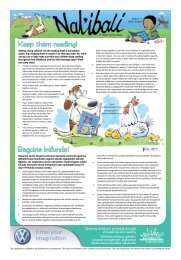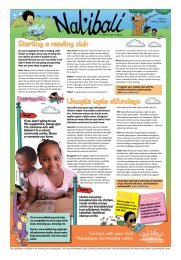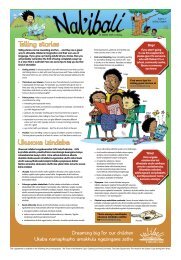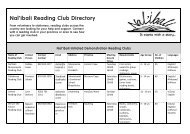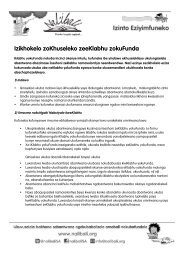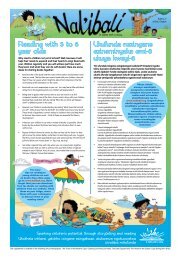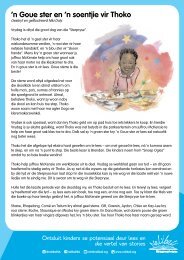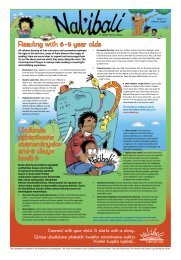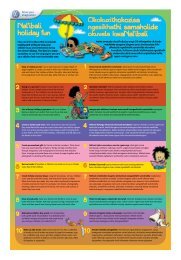Telling stories Ukubalisa amabali - Nal'ibali
Telling stories Ukubalisa amabali - Nal'ibali
Telling stories Ukubalisa amabali - Nal'ibali
You also want an ePaper? Increase the reach of your titles
YUMPU automatically turns print PDFs into web optimized ePapers that Google loves.
Edition 7isiXhosa, English<strong>Telling</strong> <strong>stories</strong><strong>Telling</strong> <strong>stories</strong> can be rewarding and fun… and they are a greatway to stimulate children’s imagination and their own use oflanguage. If you grew up having adults tell you <strong>stories</strong>, then youwill probably remember the thrill of being completely swept upin a story that is well told! Here are some tips to help you be thatkind of storyteller.Getting started. It’s always easiest to start with what you know when you firststart telling <strong>stories</strong>, so start with ones that you know well. These could be <strong>stories</strong>that were told to you as a child or ones that you have enjoyed reading over theyears.Think about your listeners. Choose a story that will interest your listeners andis appropriate for their ages. For example: you wouldn’t tell a ghost story tothree year olds, but teenagers might enjoy it! Young children love <strong>stories</strong> aboutthemselves and about you when you were young, especially ones that arefunny or about you being naughty!facial expressions, gestures and whether youhave used too many ‘ums’ or ‘ahs’!Fresh and interesting. Keep storytelling excitingfor yourself by finding new <strong>stories</strong> to tell – lookin books or on the Internet. Translate and adaptthose <strong>stories</strong> that are only available inone language.NeoGogoAfrikaStop!If you aren’t goingto use this supplement,please give it to someonewho will! Deliver it to aschool, community centre,library or someoneyou know.Find more tips fortelling great <strong>stories</strong> atwww.nalibali.orgPaint a picture. Help to create a sense of wonder and pictures in the minds ofyour listeners by using:o interesting and expressive wordso questions that invite your listeners to participate, for example, ‘And what doyou think happened next?’o gestures, for example, reaching up to show how tall a tree or giant iso facial expressions, like smiling to show how happy a character waso expression in your voice: you can give different characters differentvoices such as a soft, squeaky voice for a mouse and a big, boomingvoice for a giant.o eye contact with your listeners – don’t be shy, look them in the eye!Practise. If you are telling a story to a group of children, practise in advance.The best place to practise is in front of a mirror. You’ll be able to check yourBellaMbali<strong>Ukubalisa</strong> <strong>amabali</strong><strong>Ukubalisa</strong> <strong>amabali</strong> kusenokuba nembuyekezo nolonwabo...kwaye yindlela engcono yokukhuthaza ukucinga kwabantwananokusebenzisa ulwimi lwabo. Ukuba ukhule ubaliselwa<strong>amabali</strong> ngabantu abadala, inokuba usayikhumbula indlelaowawuthwebuleka ngayo libali elibaliswa kamnandi nangendlelaeyiyo! Nazi ke ezinye zeengcebiso ezinokukunceda nawe ubengumbalisi-mabali ogqwesileyo!Isiqalo: Kusoloko kulula ukuqala ng<strong>amabali</strong> owaziyo xa uqala ukubalisa<strong>amabali</strong>, ngako oko qala ngowaziyo. La isenokuba ng<strong>amabali</strong>owawabaliselwa ngethuba wawusengumntwana okanye lawowawuwonwabele ngelixa wawuwafunda kwiminyaka edlulileyo.Cinga ngabaphulaphuli bakho: Chonga ibali eliza kunika umdlakubaphulaphuli bakho nelilungele iminyaka yabo. Umzekelo: umntwanaoneminyaka emithathu awunakumbalisela ibali lesiporho, ngelixa abobafikisayo basenokulonwabela ibali elinjalo! Abantwana abancinci bathanda<strong>amabali</strong> anento yokwenza nabo nalawo amalunga nawe ngethubawawusakhula ingakumbi lawo angaqhelekanga okanye amalunga nezintoezisecaleni owawuzenza ngemihla yobuntwana bakho!Zoba umfanekiso: Ncedisa ekwenzeni abaphulaphuli bakho bazivebenomnqa okanye bemangalisiwe futhi bazenzele owabo umfanekisongqondweningokusebenzisa:o amagama namabinzana abonisa imvakaleloo imibuzo eyenza abaphulaphuli bakho bathathe inxaxheba, umzekelo,‘Inokuba kwenzeka ntoni bethu emva koko?’o izilinganisi, umzekelo, ukuphakamisela phezuluukubonisa ubude bomthi okanye ubukhuluo imbonakalo yobuso, njengokuncumaukubonisa ulonwabo lomlimganiswao imvakalo-zwi: abalinganiswaabohlukeneyo unokubanika amazwiohlukeneyo afana nelithambileyo,elitswinayo xa ulinganisa impuku, elikhuluxa ulinganiso isidalwa esikhuluo amehlo – sukoyika, bajongeabaphulaphuli bakho, bajonge ngqo!Yima!Ukuba awuyisayikulusebenzisa olu shicilelo,nceda ulunike omnye umntuoya kulusebenzisa! Liseesikolweni, kwiziko,labahlali, elayibhrariokanye kumntuomaziyo.Zilungiselele: Ukuba ubalisa ibali kwiqelalabantwana, zilungiselele kwangaphambili. Eyonandawo ilungele ukuzilungiselela sisipili. Esipilini uba nako ukubona imbonakaloyobuso bakho, ukusebenzisa kwakho izandla ube nako nokuqaphelaukuthintiliza kwakho!Ukuhlaziyeka nokunika umdla: Kugcine kunika umdla ukubalisa kwakho<strong>amabali</strong> ngokusoloko usiza n<strong>amabali</strong> amatsha. Khangela <strong>amabali</strong> ezincwadiniokanye kwi-intanethi anokubaliseka kakuhle. Waguqulele lawoafumaneka ngolwimi olulolunye.Fumana ezinye iingcebiso ngokubalisa<strong>amabali</strong> ngendlela echubekileyo kulewebhusayithi www.nalibali.orgDreaming big for our childrenSinamaphupha amakhulu ngabantwana bethuThis supplement is available in the following Avusa newspapers: The Times in the Western Cape, Gauteng and KwaZulu-Natal; The Daily Dispatch and The Herald in the Eastern Cape during term times.
“Just yesterday we had a wonderful experience with themini-book in your first supplement, Books are friends,with a group of students. We have two copies of thesupplement. I read the English with expression and helpedthe students with their pronunciation as they read it. Thenthey read with me in isiXhosa and helped me with mypronunciation and understanding. They were so impressedthat I knew what they were reading about! What a funhour we had – and, not being a mother-tongue speaker ofisiXhosa, it was such a boost for me!”Michelle, Ikhwili Primary School, Kei Mouth, Eastern Cape“Goxhill Primary says 'Thank you'– our newspapers containing thewonderful Na’libali supplementwere delivered at 8am today!”Brenda, KwaZulu-NatalDear <strong>Nal'ibali</strong>...Mhleli we<strong>Nal'ibali</strong>...Write toNal’ibali at PO Box1654, Saxonwold, 2132 orletters@nalibali.orgBhalela kwi: Nal’ibali,PO Box 1654, Saxonwold,2132 okanye kwi:letters@nalibali.orgFive easyways to usethe <strong>Nal'ibali</strong>supplementsat yourreading club1. Choose one of the mini-books or zig-zag booksto use in a read-aloud session. Let the childrenfollow in their own copies as you read to them.2. Use some of the ‘Get story active’ ideas asreading club activities.3. Become familiar with the ‘Story corner’ <strong>stories</strong>and then tell them to the children.4. Let older children read the ‘Story corner’ <strong>stories</strong>on their own or to younger children.5. Get as many copies of the supplements as youcan. Cut them up to create the mini-books,zig-zag books and longer <strong>stories</strong>. Create alending library for reading clubmembers so that they can borrowthese books and read them athome with family members.Iindlelaezintlanu ezilulazokusebenzisaihlelolwe<strong>Nal'ibali</strong>kwiqela lakhoelifundayo1. Chonga enye yeencwadana okanye izig-zag ozakuyisebenzisa kwiseshini yokufundela ngaphandle.Abantwana mabalandele emva kwakho bejongekwezabo iincwadana ngeli xa ufundayo.2. Sebenzisa ezinye zeengcebiso ‘zoKwenza ibali linikeumdla’ njengomsebenzi kwiqela elifundayo.3. Ziqhelanise n<strong>amabali</strong> akwicandelo ‘leThubalokubalisa’ ze uwabalisele abantwana.4. Abantwana abadala bayalele bazifundele <strong>amabali</strong>akwicandelo ‘leThuba lokubalisa’ okanye bafundeleabancinci.5. Zama kangangoko ukufumana iikopi ezaneleyozehlelo. Zisike wenze iincwadana, izig-zag n<strong>amabali</strong>amade. Yenza ithala leencwadi elibolekisa ngezincwadana kumalungu eqela elifundayo ukuze abenako ukuzifundela ekhaya kunye neentsapho zawo.Running a reading club?Register your reading club with <strong>Nal'ibali</strong> tobe part of our network and to receive evenmore ideas and <strong>stories</strong> for your club. Visitwww.nalibali.org and click on “join” – it'squick and easy.Ngaba uqhuba iqela elifundayo?Bhalisa iqela lakho elifundayo kwiNal’ ibali ukuzeube yinxalenye yothungelwano lwethu ufumaneleiqela lakho elifundayo ezinye iingcebiso ng<strong>amabali</strong>.Ndwendwela le webhusayithi www.nalibali.org zeucofe ku “join” – kulula kwaye kuyakhawuleza.Create your own mini-book1. Take out pages 3 to 6 of thissupplement.2. Fold it in half along the blackdotted line.3. Fold it in half again.4. Cut along the red dotted lines.Zenzele eyakho incwadana encinane1. Thabatha amaphepha ama-3 ukuyakwisi-6 kweli hlelo.2. Wasonge esiphakathini kumgcawamachaphaza amnyama.3. Phinda uwasonge esiphakathini kwakhona.4. Sika kwimigca yamachaphaza abomvu.2
Get story active!After you and your children have read Father Snail, try out someof these ideas.If you have 10 minutes…If you have 30 minutes…If you have one hour…Yenza ibali linike umdla!Emva kokuba ufunde nabantwana bakho ibali elithiUTat’uNyekevu, zama ezinye zezi ngcebiso.Ukuba unemizuzu eli-10…Ukuba unemizuzuengama-30…Ukuba uneyure…Meet the <strong>Nal'ibali</strong>charactersGogoGogo is Neo and Mbali’s grandmother and she lives with them. Sheruns her own educare centre and that is where her reading clubmeets every Saturday afternoon. There are 30 children in her readingclub and Gogo has four volunteers who help her. She can speak allof the home languages of the children in the club – and some otherlanguages too! Gogo speaks isiZulu, isiXhosa, Sepedi and Englishand she’s just started learning French! Gogo is always busy butthere is nothing she likes more than to relax with a cup of tea and aromance novel or a good story on the radio!Dibana nabe<strong>Nal'ibali</strong>uGogoUGogo ngumhakhulu kaNeo noMbali kwaye bahlala kunye.Unesikolo sakhe sabantwana abancinci kwaye kulapholidibanela khona iqela lakhe elifundayo rhoqo emvakwemini ngemiGqibelo. Iqela lakhe elifundayo linabantwanaabangama-30 namavolontiya amane ancedisa uGogo.Uzithetha zonke iilwimi zasekhaya zabantwana abakwiqelalakhe elifundayo – kanti nezinye iilwimi uyazithetha!UGogo uthetha isiZulu, isiXhosa, iSepedi nesiNgesi kwayeusandula kuqala ukufunda isiFrentshi! UGogo ungumntuosoloko exakekile kodwa akukho nto ayithanda ngathikukuzonwabela nekomityi yakhe yeti nenoveli yothandookanye ibali elimnandi likanomathotholo!3
Story cornerHere is the first part of a story about telling the truth foryou to read aloud or tell.The truth tree (Part 1)by Nola TurkingtonOnce, long ago, the King ofLesotho had only one child.When the king was veryold, he called his daughter,‘My daughter, it is time foryou to find a husband.’So the Princess went outto find a wise woman toask for her advice. ‘MyPrincess,’ the wise womansaid, ‘look for an honestyoung man who willalways tell the truth.’So the Princess sent thefastest runners to thefurthest corners of Lesotho.Each runner carried thismessage: When the nextfull moon is big and bright, young men can meet our Princess at herfather’s Great Place. The Princess wishes to find the right husband. Offthey went to spread the Princess’s message across Lesotho. Lesedi, ayoung man who swept the floors at the Great Place, heard the news andmade up his mind to attend.The next time the moon was big and bright, Lesedi arrived at the GreatPlace. He found men that were big or thin, men that were tall or short,smiling men and men with worried faces all waiting to meet the Princess.The Princess arrived and spoke to the men, ‘Each man will receive a potand a seed from a tree. Go home and plant the seed in the pot. Wait forsix months. The first time the new moon climbs the sky after that, return tothe Great Place with your pot. Then I will choose my husband.’‘Surely, the Princess will choose the man who grows the healthiest tree tobe her husband,’ the men whispered to one another.Lesedi took his pot and seed home and asked his mother to help him.His mother, who was a good gardener, showed her son where to findthe best soil and how deep to plant the seed. Lesedi planted the seedvery carefully. He put his pot in a sunny place, then a shady place, andwatered it a little each day. He said a prayer every night before he wentto bed. But nothing happened. No tiny tree appeared.Illustrations by Vincent NkhomoImifanekiso ngu-Vincent NkhomoIthuba lokubalisaNasi isigaba sokuqala sebali elimalunga nokuthetha inyanionokulifundela ngaphandle okanye phezulu okanye ulibalise.Umthi wenyaniso (Isigaba soku-1)Ngokubhalwa nguNola TurkingtonKudala-dala, iNkosi yaseLisuthu yayinomntwana omnye. Yathi iNkosiisakubona ukuba sele iguge kakhulu, yabiza intombi yayo yathi, ‘Ntombiyam, ngoku lixesha lokuba uzifumanele umyeni.’INkosazana yahamba yaya kwinkosikazi ephaphileyo enamavangeliyokucela iingcebiso ngalo mba. ‘Nkosazana yam,’ yatshoinkosikazi,‘khangela umfana onyanisekileyo oza kusoloko ethetha inyani.’INkosazana yathumela ezona mbaleki zinamendu ukuba ziye kwimidayeLisuthu. Nganye kwezi mbaleki yayiphethe lo myalezo: Xa inyangaithwasile kwaye iqaqambile esibhakabhakeni, abafana bangabonananeNkosazana kwiBhotwe likatata wayo. Zahamba iimbaleki ukuyakusasaza umyalezo weNkosazana mbombo zone zeLisuthu. ULesedi,umfana owayetshayela eBhotwe, waziva ezi ndaba ze wazixelela ukubanaye uza kuba yinxalenye yaloo ndibano.Kwathi xa inyanga ithwasileyo kwaye iqaqambile esibhakabhakeni,uLesedi wafika eBhotwe. Wafika kukho amadoda aneziqu ezikhulunanezincinci, amadoda amade namafutshane ancumileyo naxhalabileyoonke elinde ukubonana neNkosazana.Yafika iNkosazana ze yathetha nala madoda yathi, ‘Indoda nganye izakufumana imbiza nembewu yomthi. Kufuneka ifike kokwayo iyityale kulembiza imbewu. Ilinde iinyanga ezintandathu. Ukuthwasa kwenyangaokokuqala emva koko, ibuyele eBhotwe nembiza leyo. Kulapho ke ndizakuthi ndikhethe khona oza kuba ngumyeni wam.’‘Ngokuqinisekileyo, iNkosazana iza kukhetha indoda ethe yakhulisa owonamthi mhle ukuba ibe ngumyeni wayo,’ amadoda asebezelana atsho.ULesedi wathatha imbiza yakhe nembewu wagoduka nazo ze wacelaumama wakhe ukuba amncedise. Umama wakhe nowayengumlimiwesitiya obalaseleyo, wambonisa unyana wakhe apho anokufumanakhona owona mhlaba ulungileyo nendlela amakayityale ngayoimbewu leyo emhlabeni. ULesedi wayityala ngenyameko loo mbewu.Wayeyibeka elangeni imbiza leyo, aphinde ayibeke emthunzini, kwayewayeyinkcenkceshela kancinci rhoqo ngosuku. Wayethandaza yonke imihlaphambi kokuba alale. Kodwa zange kubekho nto yenzekayo.Zange kuvele sithombo samthi.Adapted from: ‘The Truth Tree’ from Storiesthat Talk. Published by Heartlines. © 2006In your next Nal’ibalisupplement: How to read to babies and toddlersStory stars: raising a reader from birthMini-book, Can you?The final part of the story, The truth treeCan’t wait until next week for more reading andstory tips, tools and inspirational ideas?Visit www.nalibali.org or find us on Facebook:www.facebook.com/nalibalireadingclubsFind uson Twitter:@nalibaliSifumanekuTwitter:@nalibaliKwihlelo elilandelayole<strong>Nal'ibali</strong>: Indlela yokufundela iintsana nabantwana abancinciImbalasane y<strong>amabali</strong>: ukumkhulisa engumfundikwasekuzalweniIncwadana, Unako?Icandelo lokugqibela lebali elithi uMthi weNyanisoKunzima ukulinda iveki ezayo ukuze ufumane ezinye iingcebisozokufunda n<strong>amabali</strong>, izixhobo neenkuthazo? Ndwendwela kulewebhusayithi www.nalibali.org sifumane nakuFacebook:www.facebook.com/nalibalireadingclubsSupplement produced by The Project for the Study of Alternative Education in South Africa (PRAESA) and Avusa Education. Translated by Xolisa Tshongolo. Character illustrations by Rico.4
Read the original story, Father Snail published by New Africa Books andavailable in bookstores. This story is also available in isiZulu, isiXhosa,Afrikaans, Siswati, Sepedi, Sesotho, Setswana, Xitsonga, Tshivendaand isiNdebele.New Africa Books publishes books for young readers in all elevenemail info@newafricabooks.co.zaFunda uqobo lwebali elithi UTat’uNyekevu elipapashwe ngabakwaNewAfrica Books nelifumaneka kwiivenkile zeencwadi. Eli bali likwafumanekangesiZulu, ngesiNgesi, nge-Afrikaans, ngeSiswati, ngeSepedi,ngeSesotho, ngeSetswana, ngeXitsonga, ngeTshivenda nangesiNdebele.AbakwaNew Africa Books bapapasha iincwadi zabantwana ngazozolishumi elinanye iilwimi zoMzantsi Afrika ezisemthethweni. Ukufumanaiinkcukacha ezithe vetshe ngeencwadi zabakwaNew Africa Bookssibhalele kule meyile info@newafricabooks.co.zaNal’ibali is a national reading-for-enjoyment initiativeto get people in South Africa – children and adults– passionate about telling and reading <strong>stories</strong>.For more information, visit www.nalibali.org.INal’ibali liphulo lelizwe lokufundela ulonwabo lokwenza abantu eMzantsiAfrika – abantwana nabantu abadala – bakuthakazelele ukubalisa nokufunda<strong>amabali</strong>. Ukuze ufumane inkcazelo ebanzi, ndwendwela ku www.nalibali.org.Father SnailUTat'uNyekevuXolisa Guzula & Turiya Magadlela5
Rabbit watched through the window as Mama Sele left forwork. Rabbit felt grumpy…Who was going to feed him andwho was going to keep him warm?Rabbit rushed to Father Snail, carrying an empty plate and anempty cup. Father Snail was still asleep. He snored. Rabbitput his fingers in his ears. What a terrible noise!He shook Father Snail. “Daddy, wake up. I’m hungry!”2Umvundla wamkroba efestileni lo gama wayehambauMama uSele esiya emsebenzini. Umvundla wazivaebujala...Ngubani owayeza kumpha ukutya kwayengubani owayeza kumgcina eshushu?Umvundla wabaleka waya kuTat’uNyekevu, ephetheipleyiti engenanto kunye nekomityi engenanto.UTat’uNyekevu wayesalele. Wayerhona kakubi. Umvundlawavala iindlebe zakhe ngeminwe. Wayesitsho ngenjaniyona ukuba mbi ingxolo?Wamshukumisa uTat’uNyekevu. “Tata, vuka. Ndilambile!”36
Father Snail slowly opened his eyes. He dragged himselfout of bed, and to the cupboard. There was no food in thecupboard! And there was no electricity to cook.“Go and fetch wood!” Father Snail grumbled.“I can’t do that alone. It is still dark outside. And it isdangerous too!” said Rabbit.UTata uNyekevu wazicenga wavula amehlo akhe. Wazirhuqaukuvuka ebhedini, ukuya ngasekhabhathini. Kwakungekhokutya ekhabhathini! Yaye, kwakungekho mbane wokupheka.“Hamba uyokutheza iinkuni!” UTat’unyekevuwambomba watsho.“Andinakukwazi ukuyenza ndedwa loo nto. Kusemnyamaapha phandle. Ndingenzakala!” watsho uMvundla.457
“You chop the wood,” said Father Snail.“Chopping wood is hard work,” said Rabbit. “You try first.”So Father Snail tried to chop the wood. But a log fell on his foot.“Ouch!” he shouted.Rabbit smiled and showed Father Snail how Mama Sele chops wood.The sun was already very high in the sky. Rabbit started tocollect the wood.“Daddy, the wood is heavy and the logs are too long for me to carry,”Rabbit complained.Father Snail bundled the wood and lifted the bundle onto his head.Rabbit had never seen Father Snail doing that before. He laughed soloud that he had to hold his tummy.6“Gawula iinkuni,” watsho uTat’uNyekevu.“Kodwa ngumsebenzi onzima ukugawula iinkuni,” watsho uMvundla.“Khawuzame wena kuqala ukuze ndibone.”UTat’uNyekevu wazama ukugawula iinkuni. Kodwa isikhuni somthisawela elunyaweni lwakhe.“Iyh-o-o!” wakhala watsho.UMvundla wancuma ze wabonisa uTat’uNyekevu indlela uMamauSele agawula ngayo iinkuni.Ilanga lalisele liphakamile esibhakabhakeni. UMvundla waqalisaukuqokelela iinkuni.“Tata, ezi nkuni zinzima kakhulu yaye nezi zikhuni zide kakhulu, mnaandikwazi ukuzithwala,” wakhalaza uMvundla.UTat’ uNyekevu wazibopha inyanda iinkuni waze wazithwala entloko.UMvundla wayengazange wambona uTat’uNyekevu esenza okongaphambili. Wahleka waqikileka de wabamba isisu sakhe.78
“What are we going to eat” asked Father Snail when theygot back home.“We can pick beans in Mama’s garden,” said Rabbit.Rabbit dragged Father Snail out to Mama Sele’s vegetablegarden. Father Snail knelt on the ground to help Rabbit pickthe beans.“Oh, my back hurts!” Father Snail moaned when he tried tostand up.Rabbit helped Father Snail up, but he lost his balance. Theyboth fell on the ground, looked at each other…and laughed!“Siza kutya ntoni?” wabuza uTat’uNyekevu xa bebuyelaekhaya.“Masichola-chole iimbotyi egadini kaMama,”watsho uMvundla.UMvundla wamrhuqela uTat’uNyekevu kwigadi yemifunokaMama uSele. UTat’uNyekevu waguqa emhlabeniwancedisa uMvundla bacholachola iimbotyi.“Owu, umqolo wam ubuhlungu!” UTat’uNyekevu watshoegcuma ziintlungu xa wayezama ukuphakama.UMvundla wancedisa uTat’uNyekevu ukuba eme, kodwanaye watyibilika. Batyibilika bobabini, bajongana...bahleka!899
Now there was wood and animbawula tin to make a fire.There were beans to makesoup. But there was no Mamato cook!“Now what can we do?”Rabbit asked.“We can’t eat raw beans,” saidFather Snail.“I can’t cook!” said Rabbit. “Ican’t even make a fire!”Ngoku zazikhona iinkuninembawula yokwenza umlilo.Kwakukho neembotyi zokwenzaisuphu. Kodwa kwakungekhomama wokuphekela!“Ngoku sithini?” wabuzauMvundla.“Angeke sitye iimbotyiezikrwada,” watshouTat’uNyekevu.“Andikwazi ukupheka mna!”watsho uMvundla. “Andikwazinokubasa oku!”101110
Father Snail looked at Rabbit and smiled.“I know what we can do!” he said.“You know how to cook?” Rabbit asked.“Well, not exactly, but I can always try. Watch yourclever father!”Father cooked for the firs time! He tripped and spilled thebeans. There were more beans on the ground thanin the pot!UTat’uNyekevu wajonga kuMvundla wancuma.“Ndazi kakuhle ukuba masenze ntoni!” watsho.“Uyakwazi ukupheka?” wabuza uMvundla.“Ee, hayi ngokupheleleyo, kodwa ndingazama. Bukela njewena utata wakho onengqondo!”UTat’uNyekevu wapheka okokuqala ebomini bakhe! Wathiesapheka wakhubeka wazichitha iimbotyi. Zachithakalaiimbotyi ezininzi, zaninzi eziphantsi ngaphezu kwezozisembizeni!121311
The soup was ready! Father Snail and Rabbit sat around thefire, eating soup together. When Mama Sele came home inthe evening, she couldn’t believe her eyes.“Who made the fire? Who made this food? Who cleanedthe house?”“We did!” said Father Snail proudly.“And we had lots of fun!” smiled Rabbit.Isuphu yayisele ilungile! UTat’uNyekevu noMvundla bahlalangasemlilweni, besitya isuphu kunye. Wathi xa uMama uSeleebuyela ekhaya ngokuhlwa, akayikholelwa into ayibonayo.“Ngubani obase umlilo? Ngubani opheke oku kutya?Ngubani ococe indlu?”“Sithi!” watsho uTat’uNyekevu ngebhongo.“Yaye besikonwabele konke oku!” wancuma uMvundla.141512



